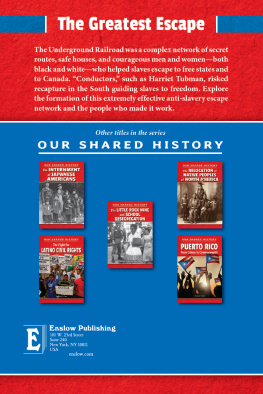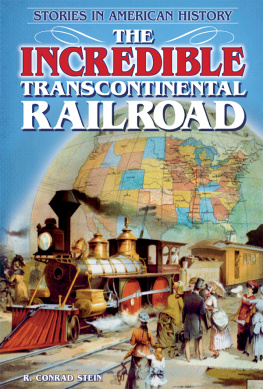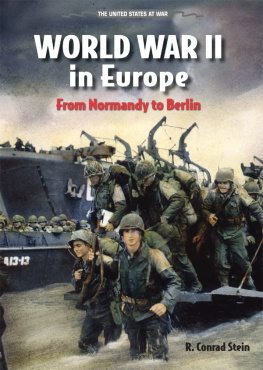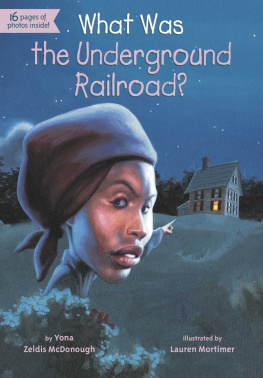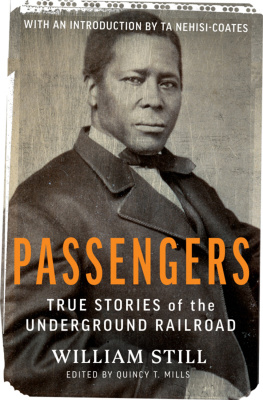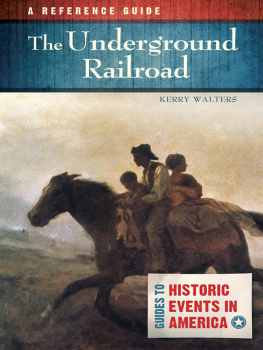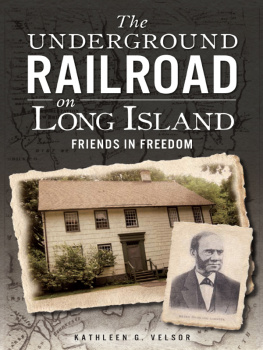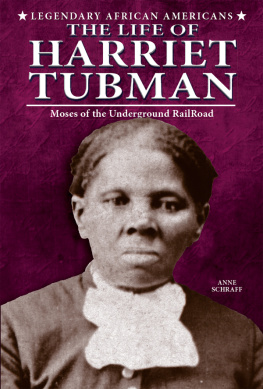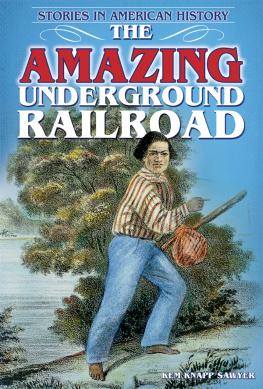Published in 2016 by Enslow Publishing, LLC
101 W. 23rd Street, Suite 240, New York, NY 10011
Copyright 2016 by R. Conrad Stein
Enslow Publishing materials copyright 2016 by Enslow Publishing, LLC
All rights reserved.
No part of this book may be reproduced by any means without the written permission of the publisher.
Cataloging-in-Publication Data
Taylor, Charlotte.
The Underground Railroad / by Charlotte Taylor and R. Conrad Stein.
p. cm. (Our shared history)
Includes bibliographical references and index.
ISBN 978-0-7660-7014-1 (library binding)
1. Underground Railroad Juvenile literature. 2. Fugitive slaves United States History 19th century Juvenile literature. 3. Antislavery movements United States History 19th century Juvenile literature. I. Taylor, Charlotte. II. Stein, R. Conrad. III. Title.
E450.T39 2016
973.7115d23
Printed in the United States of America
To Our Readers: We have done our best to make sure all Web site addresses in this book were active and appropriate when we went to press. However, the author and the publisher have no control over and assume no liability for the material available on those Web sites or on any Web sites they may link to. Any comments or suggestions can be sent by e-mail to .
Portions of this book originally appeared in the book Escaping Slavery on the Underground Railroad.
Photo Credits: AlexPlank/Wikimedia Commons/Wcpennington.jpg/public domain, p..
Cover Credit: SuperStock/Getty Images (The Underground Railroad by Charles T. Webber); ilolab/Shutterstock.com (textured background).
CONTENTS
Chapter 1 A Daring Escape
Chapter 2 Slavery in America
Chapter 3 A Growing Unrest
Chapter 4 The Birth of the Railroad
Chapter 5 The Risky Ride to Freedom
Chapter 6 Black Heroes of the Railroad
Chapter 7 Harriet Tubman: Friend of the Fugitive
Chapter 8 Journeys End
Timeline
Chapter Notes
Glossary
Further Reading
Index
In the late 1800s, thousands of slaves made their way to freedom on the Underground Railroad.
Chapter
A Daring Escape
Tice Davids was a runaway slave with one goal: to reach the Ohio River. His fellow slaves had told him that on the other side of the river were people who hated slavery. They would help him to become a free man. But first he had to get there.
Davids owner, armed with a shotgun, chased him through the rivers and fields of Kentucky. In the eyes of the law, Davids belonged to his owner. By running away, he was considered a criminal. He could be killed at any moment.
Davids ran wildly as thorns from bushes tore his clothes and scratched his skin. He could hear dogs barking as they pursued him. Gasping for breath, he climbed a hill. At the top he saw what seemed like a miraclethe broad Ohio River flowed majestically. Davids raced down the riverbank and plunged into the icy waters.
The owner saw his slaves head bobbing above the river waters. Keeping an eye on the bobbing head, he found a boat and rowed across. He held his shotgun on his lap. The owner reasoned he would force Davids to return to the Kentucky farm. Later, he would punish the slave for the attempted escape.
Davids reached shore at the riverside town of Ripley, Ohio. Finally, luck smiled on him. The town of Ripley was a center of antislavery sentiment. As Davids ran through the streets, he saw a huge white man beckoning him. Once more, Davids was fortunate. The man was a minister named John Rankin. He owned a house high on a hilltop where he kept watch over the riverbank. Rankin considered it his God-given duty to come to the aid of runaways swimming the Ohio. Over the years, Rankin and his sons had helped many slaves escape to freedom. Rankin pointed to a place near a house where Davids could hide.
The slave owner walked the streets of Ripley. Clearly the man was confused. Moments earlier he had seen Davids pull himself from the river at this town. Now the slave was nowhere to be found. The owner scratched his head and was heard to say, [He] must have gone off on an underground road. At the time, railroads were being developed and were capturing the American imagination. Also at the time, a network of people dedicated to helping escaped slaves was being formed. Thus, a legend was born. The underground road that frustrated the Kentucky slave owner began to be called the Underground Railroad.
Runaway slaves often hid during the day and ran at night.
Crossing the Mighty Ohio
The Ohio River flows west from Pennsylvania to Illinois and stretches almost a thousand miles long. It was a major border between slave states and free states, and therefore it played an important role in the Underground Railroad movement. Although a mile wide at some points, in many places the river was narrow enough for slaves to attempt crossing.
Because there were no bridges across the river at that time, escaping slaves had three choices: They could cross by boat, on foot (if the river was frozen), or they could swim. If the river was flooded, the crossing became even more dangerous. For an escaping slave, the condition of the Ohio River could mean the difference between freedom, capture, or even death.
Crossing the Ohio River was one way for slaves to reach freedom.
Is the Tice Davids escape true or is it a story? It is known that a slave named Tice Davids swam to freedom in 1831. There was nothing new to this escape. Hundreds of slaves fled from their owners every year. Many fugitive slaves were assisted on their flight by Americans who believed that slavery was both immoral and sinful. Beginning in the early 1830s, this group of people fighting slavery came to be called the Underground Railroad. Perhaps the Tice Davids story helped to create the legendary name.
The Underground Railroad was not a railroad, nor did it run underground. Instead, it was a fellowship of men and women who risked their lives to help slaves escape their bondage. By necessity, the Underground Railroad was a loosely organized institution. Its members were lawbreakers. People who assisted runaway slaves could be sent to prison or suffer even worse punishments. Members of the Underground Railroad knew only a few other members. They used railroad terms when discussing their activities. Runaways were called passengers. Those who assisted the passengers were conductors. Houses where escapees could rest were stations. Owners of the stations were stationmasters.
Because no records were kept, it is not known how many men and women served on the Underground Railroad. Nor is it known how many slaves the Railroad helped escape.
The Underground Railroad is a heroic chapter in American history. Its membership consisted of black and white men and women. The organization helped to destroy the nations greatest evilslavery. Tales of the Underground Railroad and the dangers faced by Railroad workers and escapees have been told for generations. Still, those tales remain fresh and alive. Stories of courage never age.

